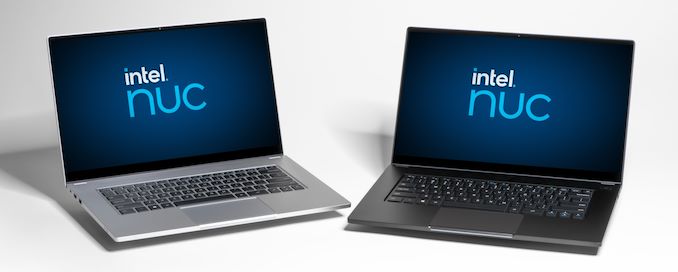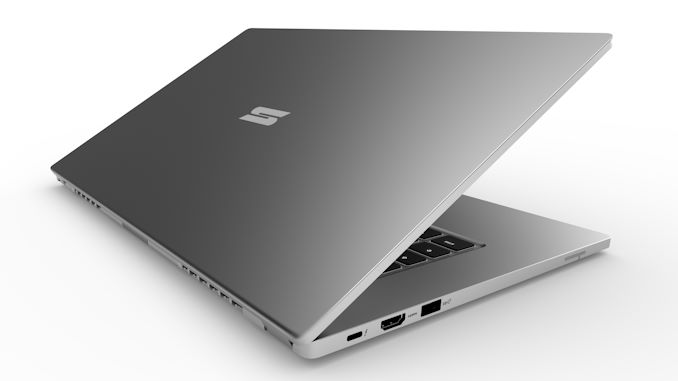Intel’s New NUC Laptop Kit: Whitebook Tiger Lake For All
by Dr. Ian Cutress on November 19, 2020 1:21 PM EST
The Next Unit of Computing branding, known as NUC (pronounced nu-ck), has long been associated with Intel’s small form factor desktop designs featuring mobile-class processors. Last year Intel broke that design philosophy with the introduction of the NUC 9 Pro, known as Quartz Canyon, which allowed for a PCIe graphics card in a unified box. Intel today is announcing the next step on the NUC journey, with a pre-built laptop featuring 10nm Quad-Core Tiger Lake Processors.
The new NUC M15 Laptop Kit (codename Bishop County) is a pre-built notebook/laptop isn’t going to be something that an end-user can purchase outright. Rather than directly compete with its laptop partners, the unit is going to be offered to Intel’s laptop partners and channel customers for them to re-brand, potentially build upon, and then resell. This is why it is called the whitebook market, and why I used whitebook in the title of this article.
The NUC M15 design uses Tiger Lake (Intel Core 11th Gen) with Xe graphics in a platform designed to meet Intel Evo requirements for premium laptop design. This means meeting minimum specifications on wake-up time, charging, Thunderbolt, Wi-Fi, and screen power consumption. Evo still needs to be applied for by each brand that takes the M15 on for itself to modify and re-sell, but Intel states that offering this whitebook model will help a lot of regional retailers offer something a bit beyond the normal range of designs with their own unique modifications.
One of the first channel partners that emailed us about their implementation of the M15 was Schenker, a Germany-based retailer that sells across Europe and other locations. Normally we see the company implement Clevo whitebook designs, and so this is something a bit different – the Schenker Vision 15 is a 15.6-inch implementation in an aluminium unibody design with a touch display, 450 nit brightness, Thunderbolt 4, a PCIe 4.0-enabled SSD, and charging options enabled through Type-C on both sides.
Inside is the quad-core Tiger Lake Core i7-1165G7 with Xe graphics, and with the 73 Wh quick-charging battery the company claims it enables 14 hours of Wi-Fi or 10 hours of H.264 local video playback (measured at 150 nits). Schenker is claiming CBR23 scores of 1537 for ST and 5990 for MT, and will offer performance profiles for regular use or peak performance (the latter peaking at 84ºC and 40.8 dB(A) according to the company). The keyboard is listed as having LED-backlighting, and Schenker will support 25 country-specific keyboard layouts.
On storage and memory, Schenker will offer a variety of PCIe 4.0 storage options, as well as LPDDR4X-4267 memory options. Both Thunderbolt 4 ports will support charging, and an additional USB 3.2 Gen 2 port is available. A Linux version will be offered by Schenker’s sister company, TUXEDO Computers.
Shipping will start in January, with the base model offering a Shadow Grey design with the Core i7-1165G7, 16 GB LPDDR4X-4267, and a 250 GB Samsung 970 EVO Plus storage drive, which will retail in Europe for €1499 ($1531 USD equivalent pre-tax). Users after PCIe 4.0 storage will be able to select various capacities of Samsung 980 Pro. Standard warranty is 36 months. Schenker hasn’t yet applied for Intel Evo certification, but has stated that it meets the standards.
We are expecting other companies to offer similar versions of the NUC M15 design, however one of the issues with the whitebook market is differentiation. With the majority of the hardware in this unit going to be the same from other Intel channel partners, the margins might be very tight. Schenker states that they are a lead partner in this collaborative design.
Source: Intel
Related Reading
- Schenker VIA 14: 14-inch Tiger Lake Magnesium Notebook, with 28W Version Inbound
- A 15-inch Thin Laptop For The Road: No More Dongles With The XMG DJ 15
- Intel Ghost Canyon NUC9i9QNX Review: NUC 9 Extreme Realizes the SFF Dream
- Intel NUC10i7FNH Frost Canyon Review
- Intel Unveils Specifications of NUC Element Modular PCs
- Intel Axes 10nm CPU Based NUC
- Intel's Bean Canyon (NUC8i7BEH) Coffee Lake NUC Review












34 Comments
View All Comments
TheinsanegamerN - Friday, November 20, 2020 - link
Netbooks. The era of the late 2000s was plagued with both cheap and expensive shit. That was why intel started the whole "ultrabook" thing, to show laptop OEMs how a proper thin and light laptop should be with their chips. OEM laptop design improved dramatically after that.Jorgp2 - Saturday, November 21, 2020 - link
tonsDanNeely - Thursday, November 19, 2020 - link
They've been making reference laptop designs to help OEMs out for years. I'm guessing some of their partners/potential partners pressured them to let them just sell the base design as is instead of having to make minor pseudorandom fiddles and then setup separate manufacturing.jamesindevon - Thursday, November 19, 2020 - link
Intel have been doing whitebox designs for decades.There were the 50 MHz 486 DX (not DX2) systems, when a lot of chipsets / motherboards / manufacturers couldn't make their existing 486 designs run at 50 MHz.
There were whitebox Pentium Pro servers, so second-tier and national manufacturers could have their own server range without much engineering (at a time when IBM, HP, Sun, Digital and others had their own RISC servers).
There were whitebox Itanium systems when Itanium 2 was new(-ish): partially because companies like IBM couldn't justify producing their own designs (they couldn't imagine who'd want to buy Itanium), and partially because Intel wanted to get everyone on board with selling Itanium, to make it more obviously The Future Of The PC.
Each time, they have been trying to grow a market.
nandnandnand - Thursday, November 19, 2020 - link
I'll take 4x user-accessible SO-DIMM slots, plz.XMG Support - Thursday, November 19, 2020 - link
You'll get 2x DDR4 SO-DIMM in future models of the VISION product family. But for the Intel reference model, they were really keen on going for LPDDR4x for the additional efficiency which helps with iGPU performance and battery life. This kind of memory is not available in socketed form and is part of the Intel Evo Platform design recommendations (although it's not a "must have" item on the requirements list). // Tomnandnandnand - Friday, November 20, 2020 - link
Thanks for the info.Duncan Macdonald - Thursday, November 19, 2020 - link
16 GB of RAM may be OK but not having only 250GB of SSD in a laptop costing over $1500 - at that price it should have at least a 1TB drive.I know that Intel is trying to push Thunderbolt - but how many users are ever likely to make use of 2 Thunderbolt ports ?
Replacing one of the Thunderbolt ports with another USB port would make for a more useful system.
The keyboard also looks bad - there is room for a full keyboard with a number pad but instead it has a cramped basic keyboard with loads of wasted space on each side.
shabby - Thursday, November 19, 2020 - link
I'd make sure the screen also isn't 1366x768.Toadster - Thursday, November 19, 2020 - link
the details show 1080p capable screen, so thankfully beyond the netbook days of 1366x768 :)